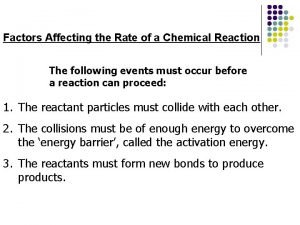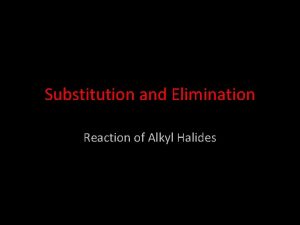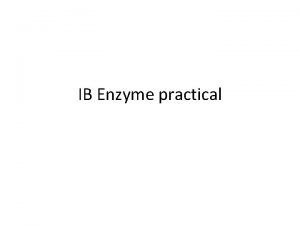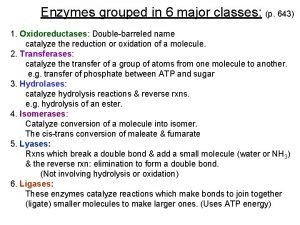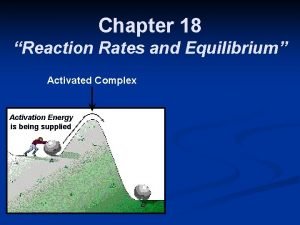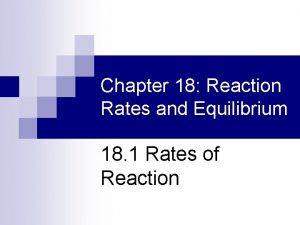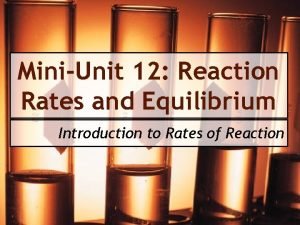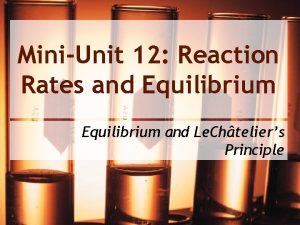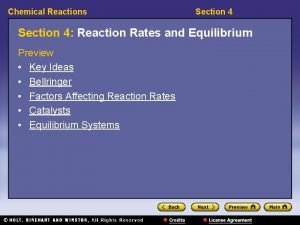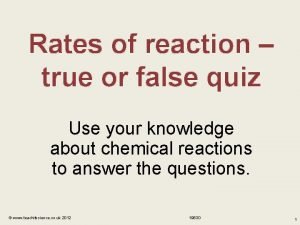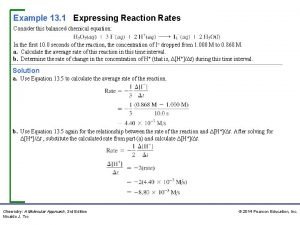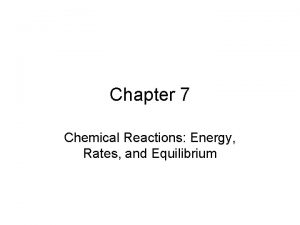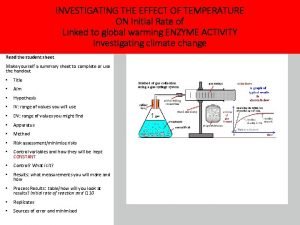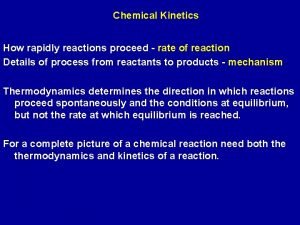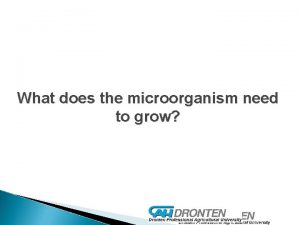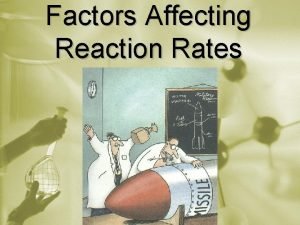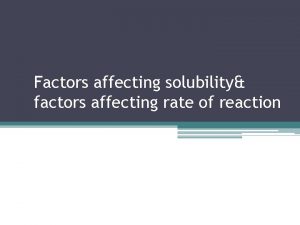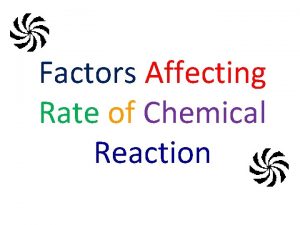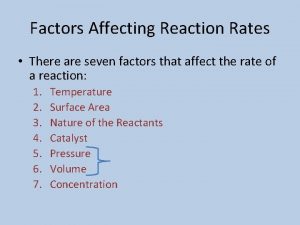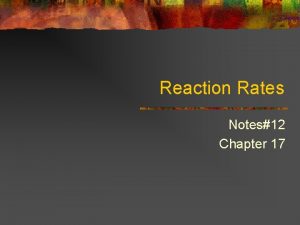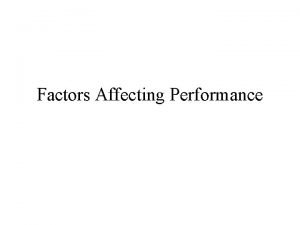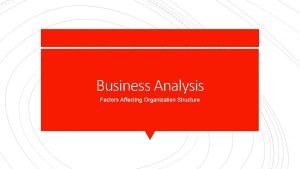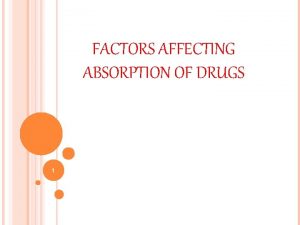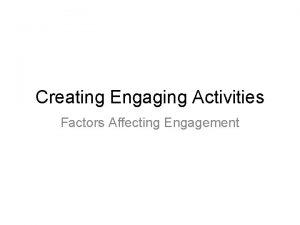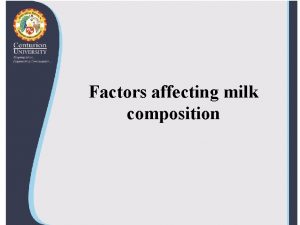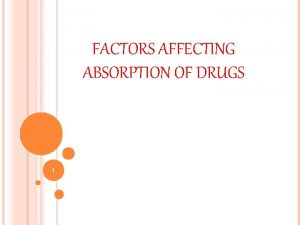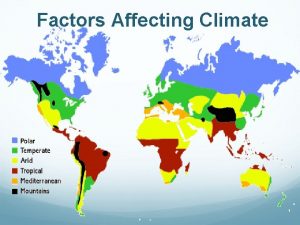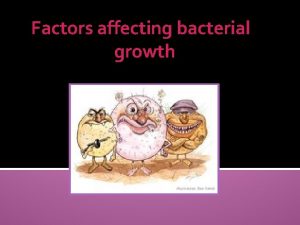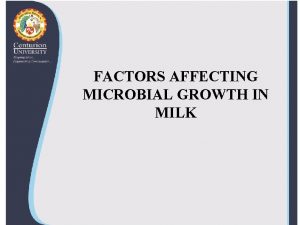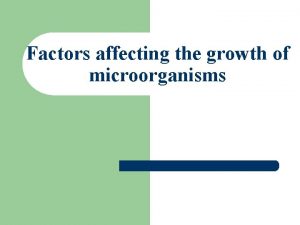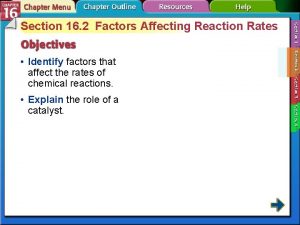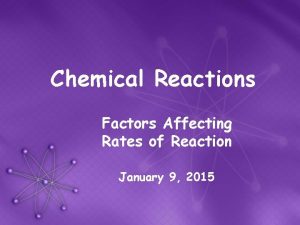CHAPTER 3 ACTIVITY 5 REACTION RATES FACTORS AFFECTING






















- Slides: 22

CHAPTER 3 ACTIVITY 5 REACTION RATES & FACTORS AFFECTING EQUILIBRIUM

Energy Diagrams Activated Complex A. E. E of reactants 2 H 2 + O 2 E of products E 2 H 2 O Energy Reaction Progress A. E. (activation energy): minimum energy needed for a reaction to occur Activated Complex: transitional structure formed from an effective collision.

Not Every Collision Produces Products Reactants must: 1. Collide with the correct orientation 2. Have enough energy to produce products.

The Reaction Process Collision Theory: Explanation of reactions as a result of collisions. – Particles must collide in the correct orientation – Collision must be energetic enough to disrupt bonds

Catalyst A substance that increases the rate of reaction without being used up itself in the reaction. Energy barrier w/o catalyst Energy barrier w catalyst Reactants Energy Products Reaction Progress


Exothermic vs. Endothermic Exothermic: – A process that loses heat to its surroundings. Fe 2 O 3(s) + CO(g) Fe(s) + CO 2(g) + 26. 3 k. J Endothermic: – A process that absorbs heat from its surroundings. 2 Na. HCO 3(s) + 129 k. J Na 2 CO 3(s) + H 2 O(g) + CO 2(g)

http: //www. mhhe. com/physsci/chemistry/essentialchemistry/flash/activa 2. swf

Is the following an example of an exothermic or endothermic reaction? Reactants Potential Energy EXOTHERMIC=energy is released Products Reaction Progress

Is the following an example of an exothermic or endothermic reaction? Potential Energy Reactants Products ENDOTHERMIC=energy is absorbed Reaction Progress

Factors Affecting Reaction Rates 1. Temperature 2. Concentration 3. Particle Size 4. Catalysts

Factors Affecting Reaction Rates 1. Temperature Temp Rate WHY Kinetic Energy

Factors Affecting Reaction Rates 2. Concentration Conc. Rate WHY More Particles increases collision frequency

Factors Affecting Reaction Rates 3. Particle Size Rate WHY Smaller Particle size increases the surface area

Factors Affecting Reaction Rates 4. Catalyst Adding a Catalyst WHY Rate Activation Energy

FACTORS AFFECTING EQ. Le Chatelier’s Principle Reactions will stabilize and establish equilibrium. If this system is disturbed from equilibrium, it will shift in order to reduce the disturbance. When any of the following three things are changed, the system will change to reestablish equilibrium. System @ Equilibrium • Concentration • Temperature • Pressure R P Systems not @ Equilibrium

Know the Difference Factors Affecting: Solubility Reaction Rates Equilibrium 1. Temperature 2. Agitation 2. Concentration 3. Particle Size 3. Pressure 4. Catalyst

Concentration If we add CO 2, more H 2 CO 3 will be made H 2 CO 3 CO 2 + H 2 O If we remove CO 2, more CO 2 & H 2 O will be made

Concentration If we remove H 2 CO 3, more H 2 CO 3 will be made H 2 CO 3 If we add H 2 CO 3, more CO 2 & H 2 O will be made CO 2 + H 2 O

Temperature If we add heat, more reactants will be made in order to absorb the excess heat 2 SO 2 + O 2 If we remove heat, more products will be made in order to replace the heat that has been removed. 2 SO 3 + heat

Pressure Only Gases Are Affected! If we increase pressure, more products will be made (less moles) 4 moles N 2 + 3 H 2 If we decrease pressure, more reactants will be made (more moles) 2 NH 3 2 moles

Review Reactions will stabilize and establish equilibrium. When any of the following three things are changed, the reaction will change to re-establish equilibrium. • • • Concentration Temperature Pressure R = P
 Temperature and activation energy
Temperature and activation energy Elimination reaction conditions
Elimination reaction conditions Factors affecting enzyme activity bbc bitesize
Factors affecting enzyme activity bbc bitesize Factors affecting physical activity
Factors affecting physical activity 6 types of enzymes
6 types of enzymes Unit rate
Unit rate Ratios guided notes
Ratios guided notes Ratios rates and unit rates
Ratios rates and unit rates Ratios rates and unit rates
Ratios rates and unit rates Chapter 18 review chemical equilibrium section 3 answer key
Chapter 18 review chemical equilibrium section 3 answer key Chapter 18 reaction rates and equilibrium answer key
Chapter 18 reaction rates and equilibrium answer key Chapter 18 reaction rates and equilibrium
Chapter 18 reaction rates and equilibrium Mini unit reaction rates and equilibrium
Mini unit reaction rates and equilibrium Mini unit reaction rates and equilibrium
Mini unit reaction rates and equilibrium Section 4 reaction rates and equilibrium
Section 4 reaction rates and equilibrium Expressing reaction rates
Expressing reaction rates Reaction rate
Reaction rate Expressing reaction rates
Expressing reaction rates Did a chemical reaction occur
Did a chemical reaction occur How to calculate initial rate of reaction
How to calculate initial rate of reaction Surface area affecting rate of reaction
Surface area affecting rate of reaction Ocean currents
Ocean currents Factors affecting microbial growth in food
Factors affecting microbial growth in food
